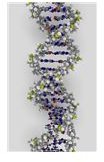Recessive Alleles Hidden In The Phenotype: How Human Inherited Traits Can Surprise You - We Explain Dominant/Recessive Traits
What Is Your Phenotype And How Is It Connected To Your Genetic Inheritance?
If you enjoy boisterous good health then you can thank your genetic inheritance – or genotype – as well as giving credit to a healthy lifestyle. But the health and functionality of the organism – that’s you! – is only the ‘phenotype’ and doesn’t necessarily tell the whole tale about the genetic inheritance it has received and may pass on to offspring. The phenotype amounts to the genes of the individual as they are actually expressed in that organism – and when recessive alleles are taken into account, it seems that some may get to be expressed more than others.
Gregor Mendel’s Contribution To Theory Of Recessive And Dominant Alleles
Gregor Mendel’s famous classic pea experiments demonstrated the existence of recessive alleles. That is, he showed that there must exist two determinants (i.e. alleles, although he did not use the same terminology as we do presently) regarding a particular characteristic of an organism. If both alleles are identical (homozygous) then this allele is expressed in the phenotype. If the gene ‘locus’ for the alleles is heterozygous i.e. with two different alleles, then one may be ‘dominant’ and the other ‘recessive’. The result of this is a phenotype (i.e. the genetic expression in the actual organism) that is identical to a phenotype with two identical dominant alleles.1 (This is a much simplified version of genetic inheritance and there are complicating factors. ‘Dominant’ and ‘recessive’ may be regarded as oversimplified terms with respect to actual phenotypical expression).2
Autosomal Recessive Disorders: What Do You Need To Know?
In autosomal (i.e. not X/Y sex chromosome determined) recessive disorders, possession of two copies of a recessive allele can lead to development of the relevant disorder. This is due to the absence of a ‘dominant’ healthy gene. Examples are Tay-Sachs, sickle-cell anaemia and cystic fibrosis. Those who are heterozygous for a gene involved in an autosomal recessive disorder, one allele being the defective recessive variant, may exhibit a completely normal phenotype.1
Carriers of a single recessive allele of a gene associated with an autosomal recessive disorder may feel some concern with respect to having children. Should they meet and marry a similar individual, what is the prospect of having healthy offspring, and what can they do about it? The actual odds of having healthy offspring were fairly well covered by Mendel.1 A carrier who knows his/her genetic inheritance may wish a partner to undertake genetic testing, just in case. If the position is known in advance then decisions may be affected by the seriousness or otherwise of the disorder in question.
References
1 ‘Inheritance’. GCSE Bitesize. (26/09/2009) https://www.bbc.co.uk <https://www.bbc.co.uk/schools/gcsebitesize/science/add_aqa/celldivision/inheritance1.shtml>
2 Zschocke, Johannes. ‘Dominant versus recessive: Molecular mechanisms in metabolic disease ‘. Springer Netherlands. Volume 31, Number 5 / October, 2008, pp. 599-618. 19/10/2008 (26/09/2009). https://www.springerlink.com <https://www.springerlink.com/content/gv665q510g3742g8/>
